The taste of mutton in Madurai
The love of the meat in the temple town makes Madurai an exception among south Indian religious centres
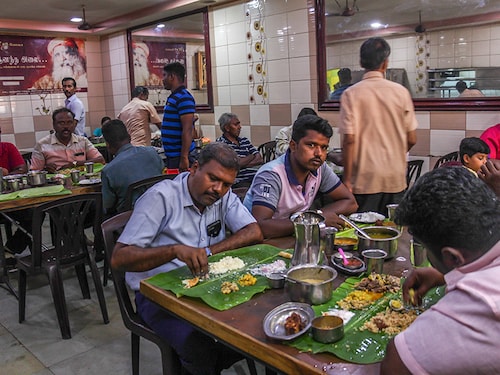

 Madurai is home to a long list of restaurants that serve varied non-vegetarian dishes
Madurai is home to a long list of restaurants that serve varied non-vegetarian dishes
Image: Rathina Sankari[br]I remember, as a 10-year-old, waking up even before the sun had made its presence felt. Although it was too early for the day’s regular morning routine to have started, downstairs I could hear a babel of voices. As I walked down the steps, I watched my maternal grandmother giving instructions to my uncle about the items to be bought from the market. Mutton topped the list, followed by goat blood and bone marrow. She was clear about the cut and quantity, for it was no normal day. It was the day of Lakshmi puja.
Meat being prepared on the occasion of Diwali might be unheard of in many parts of India. But not in the temple city of Madurai and its neighbouring towns, where butchers open their shops before the crack of dawn on this auspicious day. I have fond memories of biting into the juicy pieces of suvarotti (goat spleen), rich in iron, roasted and smeared with nothing but salt and pepper, prepared by my grandmother. It was here that I mastered the art of tapping the bones and sucking the mushy marrow out from them. She would regularly prepare karikuzhambu (mutton curry) doused with coconut paste, and the kothukarikuzhambu (mutton keema curry), which was the perfect accompaniment for idlis, dosas, parottas and pooris. But try as I might, I could never gather myself to savour the rathaporiyal (goat’s blood stir fry), a delicacy that would be prepared every Diwali.
In most religious centres of Southern India, such as Udupi in Karnataka, Tirupati in Andhra Pradesh and Guruvayur in Kerala, the culture of eating meat isn’t popular. But Madurai is home to a long list of roadside eateries and restaurants that serve varied non-vegetarian dishes. Every part of the goat is savoured: The brain, shank, trotters, head, kidneys, intestines, liver… you name it. “Besides being a temple city, Madurai has for centuries been a commercial hub for trade and commerce,” says Shanmughapriya Thyagarajan, who manages Mystical Palmyra, a heritage tours company. “This distinguishes Madurai from other temple cities, which are primarily pilgrimage centres.”
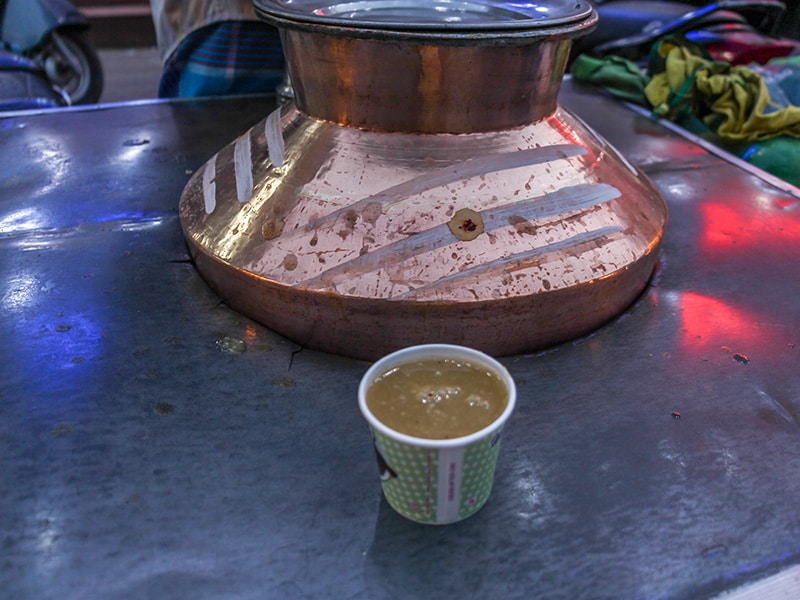 Roadside vendors sell mulu murungai vadai and paruthi paal or cotton- seed milk
Roadside vendors sell mulu murungai vadai and paruthi paal or cotton- seed milk
Images: Rathina Sankari[br]Madurai, the seat of Tamil Sangam (the renaissance of Tamil literature that spanned the 3rd century BC to 3rd century AD) and popular across the globe for the highly revered Meenakshi Amman Temple, is an ancient city with evidence of human occupation for more than two millennia. It finds mention in the writings of ancient Greek historian Megasthenes, who visited India as an ambassador around 3rd century BC. The city also finds mentions in the Greco-Roman accounts of Pliny, Ptolemy and Straboin in the 1st and 2nd centuries AD, as the region traded commodities like pepper, pearls and textiles with the Greeks and Romans. Excavations close to Madurai have also unearthed ancient Roman artefacts, such as coins.
On my biannual visits to the city of my childhood, a walk along the concentric streets surrounding the temple is a feast for the senses: The woody, creamy fragrance of sandalwood paste as you pass by a sandalwood vendor, the waft from the seductive Madurai malli (jasmine) as you cross women wearing flowers in their hair, the noise of traffic, the towering, colourful gopurams (spires) of the temple, the aroma of fresh, soft idlis from roadside corner shops.
The city has many names, each referring to its many legends and attributes: The name Koodal refers to the congregation of scholars during the Tamil Sangam, while the name Madhura refers to the legend that ‘madhura’ or nectar flowed from the matted locks of Lord Shiva into this region and the people from far and near who visit the city for commercial purposes have given it the sobriquet Thoonga Nagaram, or the city that never sleeps. The vegetable market, fruit market, flower market and fish market function through the night, with cargo being unloaded, packaged, distributed and sold. Devika Marivel runs the 40-year-old Burma Idiyappam Kadai
Devika Marivel runs the 40-year-old Burma Idiyappam Kadai
Image: Rathina Sankari[br]To cater to these throngs of people, roadside eateries and tea and coffee shops work through the night. “At two in the morning, you can get piping hot biryani, kothuparotta, string hoppers, idli, tea… you name it,” says Praveena Mukunthan, who hosts food trails called Foodies Day Out in Madurai. Both vegetarian and non-vegetarian fare is served in all these restaurants and street food joints.
Madurai is also home to numerous joints called ‘mess’. They have their origins in the rustic, makeshift roadside stalls that locals set up to sell home-made food. These soon flourished and moved into permanent, but no-frills, set-ups. Amma Mess, Kumar Mess and Chandran Mess are some of the big names that serve a few vegetarian dishes, and focus more on meat dishes that are pocket-friendly and have a home-made taste. Mutton brain roast, kola urundai (meat balls), liver roast, kaadai (quail) roast, turkey biryani, crab pepper fry, mutton egg parotta, and mutton curry dosa are some of the dishes that typically appear on the menus of these joints. “The region has an abundance of karuvelam trees or Prosopis juliflora, which the goats feed on. Hence the easy availability of mutton,” says Shanmughapriya.
*****
Every year in the scorching heat of May, a motley crowd that was my family would bundle into a state-run bus, which would move at a snail’s pace to my maternal grandfather’s village Lakshminarayanapuram, 60 km from Madurai. The purpose of this trip was to celebrate the kedavettu Pongal, a festival celebrated with goat sacrifices at the Kali Amman village temple. A fun-filled week-long affair, it involved folk dance performances, women carrying mulaipari (nine grains germinated in clay pots) on their heads, preparation of Pongal (sweet rice) by the women, and the sacrifice of goats and chicken to the village deity.
The slaughtered goat would be taken back to the courtyard of its owner’s house to be butchered. Some of the meat would be used to make biryani, mutton curry and varattukari (mutton fry), the rest would be salted and dried to make uppukandam, or jerked meat, which has a long shelf life. These would be consumed either as a curry to be had with rice, or fried in oil as a side dish in a traditional South Indian meal. I would always persuade my grandmother to pack large quantities of uppukandam for me while leaving my hometown. A lover of mutton, on her death anniversary her children continue to prepare different mutton delicacies in her remembrance every year.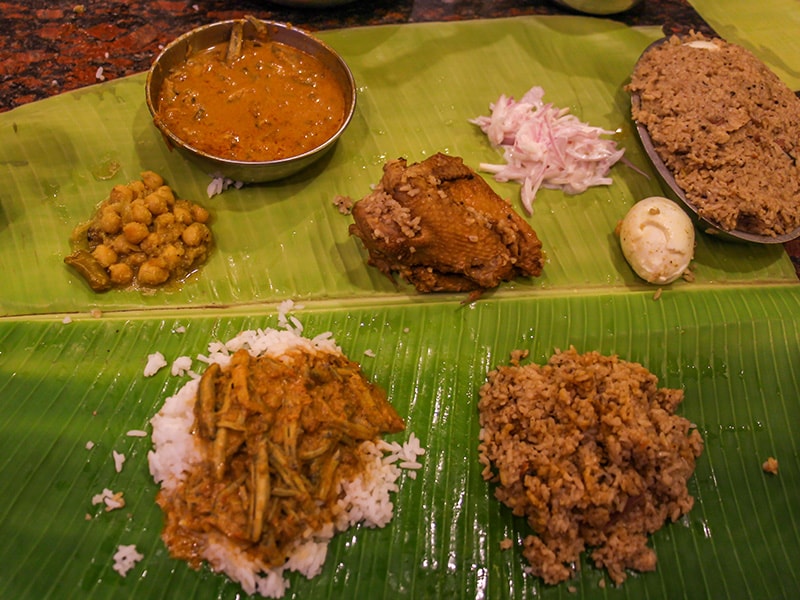 A non-vegetarian meal where Ayira Meen Kulambu is served with white rice
A non-vegetarian meal where Ayira Meen Kulambu is served with white rice
Image: Rathina Sankari[br]Such is the love for meat in this region that when girls attain puberty, a lavish feast is thrown for friends and relatives, which includes rich non-vegetarian fare. When one-year-olds are tonsured at clan temples, and their ears pierced, Pongal is prepared in earthen pots and a goat is sacrificed. Guests are served meat dishes for lunch.
In recent years there has been an influx of Western fast food in the city. “But Madurai residents still go back to their traditional food as their go-to food. However rich they might be, they have no qualms about waiting at a roadside stall for their favourite local delicacy,” says Praveena. 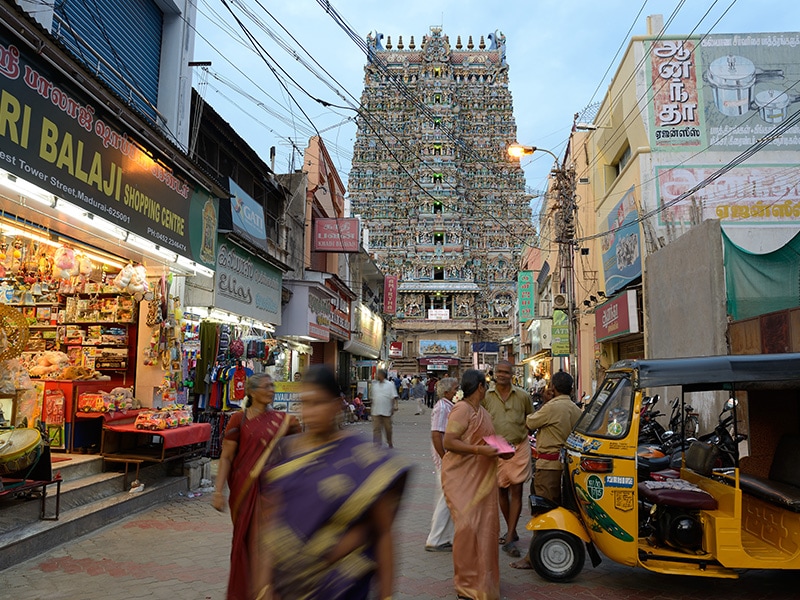 Meenakshi temple, Madurai
Meenakshi temple, Madurai
Image: Frédéric Soltan / Corbis via Getty Images[br]There is, of course, more to Madurai’s food scene than meat. The city has a substantial presence of Saurashtraians, whose ancestors migrated from Saurashtra in Gujarat. In the early 17th century, Madurai was ruled by King Thirumalai Nayaker—he also constructed a namesake magnificent palace—who invited the Saurashtraians to live in the city, thus bringing their expertise in weaving, and giving Madurai the famous sungudi weave.
Also called Patnulkarar, or silk weavers, the Saurashtrian community has contributed immensely to the city’s cuisine and culture. On my visits to the city, I often drop in on my father’s friend, a Saurashtrian. Their puliyodharai, or tamarind rice, is the calling card of my sojourns. I have had this simple dish in many homes across the state, but nothing beats the preparation of a Patnulkarar.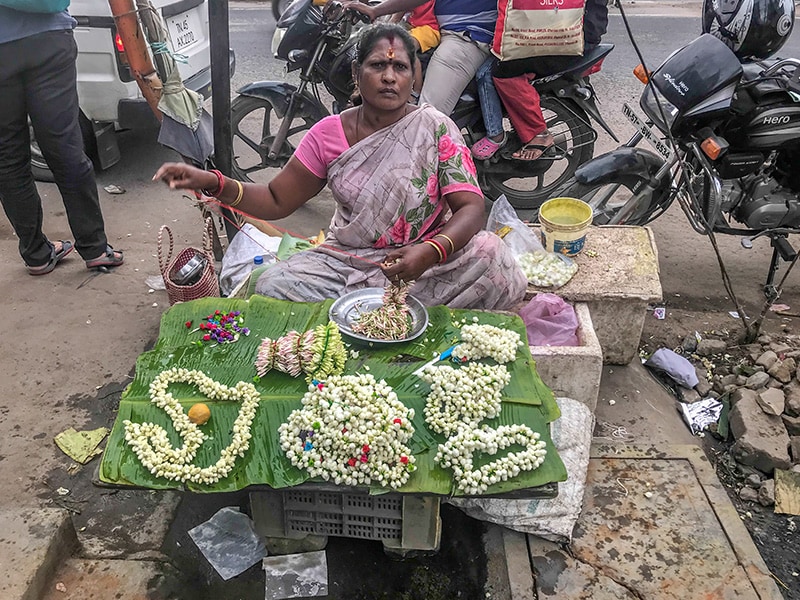
The Madurai malli is synonymous with the city
Image: Rathina Sankari[br]To relish the other specialities of the city, head to the roadside stalls opposite Sarveshwarar Temple. Mulu murungai vadai (rice-based, deep fried savoury snacks made with the leaves of Erythrina variegata) and ragi vadai (a deep-fried snack made of finger millet with shallots and curry leaves) are served hot and fresh, off the stove in the evenings. The halwa shops of Madurai have contributed immensely to its fame, such as the century-old Nagapattinam Halwa Shop on Chitrai Street, and the Prema Vilas sweet shop on Town Hall Road. When this gooey sweet made of wheat flour, loaded with ghee, melts and slides down your throat, it is indeed poetry. A packet of this sure does find a place in my bag whenever I visit the city.
As you stroll down its streets you are bound to notice many cycle carts mounted with a brass pot containing hot paruthipaal or cotton-seed milk. Mixed with palm jaggery and laced with dried ginger, grated coconut and cardamom, it is said to improve digestion and blood circulation and ensures good functioning of the nervous system. Another highly irresistible drink is the jigarthanda, made with almond resin, china grass, sarsaparilla syrup, basundi, chilled milk, lots of sugar and topped with a scoop of ice cream. This decadent dessert is the perfect antidote for Madurai’s heat. The best place to down a glass of this would be one of the numerous outlets of Famous Jigarthanda that dot the city.
About 4 km from the Meenakshi Amman temple is the teppakulam, or the temple tank of the city. Every evening you will find a couple making and selling hot puttu, or steamed rice cakes, from a pushcart beside the tank. This healthy snack is best had by sprinkling sugar or jaggery and grated coconut on it.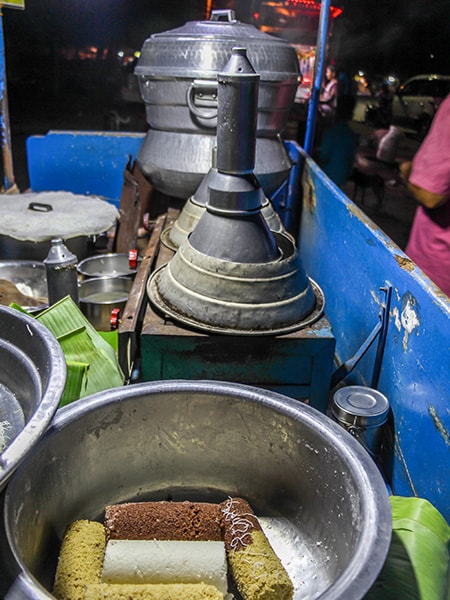 Puttu or steamed rice cakes find references in the Thiruvilayadal Puranam
Puttu or steamed rice cakes find references in the Thiruvilayadal Puranam
Image: Rathina Sankari[br]
Whenever I dig into a plate of puttu I am reminded of my paternal grandmother, who would narrate the riveting tales of Lord Shiva’s divine acts, with Madurai as his playground, from the Thiruvilayadal Puranam. One such story says that when the river Vaigai flooded the city, the Pandya king issued an order that a member from every family would help in building a bund on the river banks. But Vanthi, a lone woman, couldn’t take up this work due to old age. Shiva appeared before her in the guise of a young man and agreed to work on her behalf if she fed him puttu. To this day the city celebrates the festival of puttu every year to commemorate this event.
I stop by Janakiram, a non-vegetarian restaurant, to relish some of the city’s specialities. I order Ayira Meen Kulambu, a fish curry made with the tiny spiny loach that is indigenous to this region and is found in the marshy beds of its dams, lakes and rivers. I know it cannot rival my maternal grandmother’s preparation, but I take the plunge nonetheless. The flavours of the dish transport me to her home: I see her, clad in a sari, a towering figure, as she stood at the gate talking to the fishmonger, checking the day’s catch mounted on his bicycle with an adept eye.
Madurai continues to be my favourite food playground for life.
First Published: Apr 25, 2020, 10:10
Subscribe Now